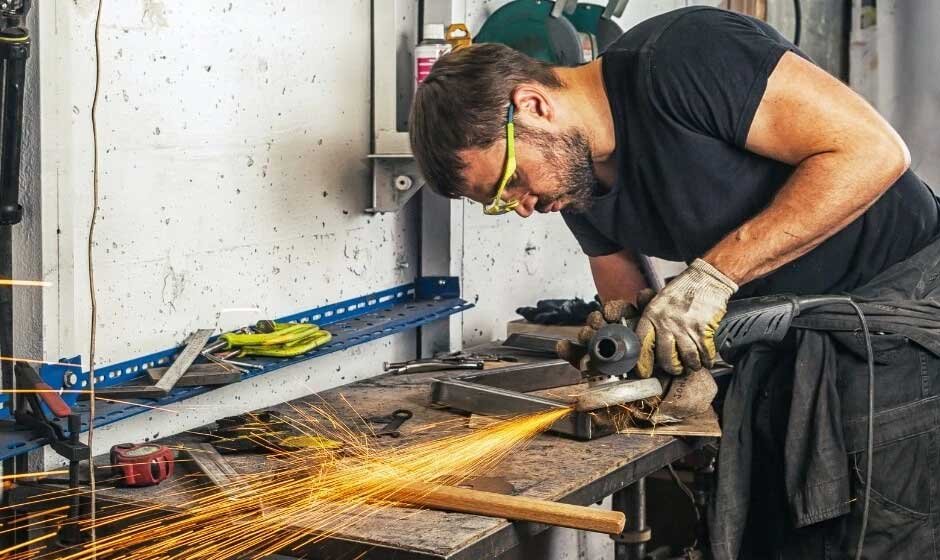Grinding might seem straightforward, but cutting, polishing, finishing and grinding operations can be dangerous. Flying debris, sparks, loud noises and unexpected equipment malfunctions are just a few of the risks grinding brings along. Ignoring safety can lead to severe injuries or even fatal accidents.
Understanding these risks is the first step toward creating a safer grinding environment and recognising why these control measures are non-negotiable helps keep everyone safe.
Identifying Hazards in Grinding Operations
Every grinding job comes with its own set of hazards. Recognising them can ensure safety and lower the chances of an accident.
- Flying Debris: When grinding, tiny particles and sharp fragments are likely to fly off in all directions. These can cause severe eye injuries or cuts if not protected against.
- Sparks: Grinding generates sparks, especially when working on metal. Though small, sparks can cause burns or ignite flammable materials nearby.
- Dust:Grinding creates fine dust particles that can be hazardous if inhaled. Long-term exposure, particularly to metal or silica dust, can lead to respiratory issues.
- Noise: Grinding machines are noisy. Long-term exposure to high-pitched sounds can lead to hearing loss, making ear protection essential.
- Equipment Malfunctions:Machines break down or experience technical issues at times, leading to unexpected and dangerous scenarios. These malfunctions can be due to wear and tear, improper handling or faulty maintenance.
Personal Protective Equipment (PPE) for Grinding Safety
The proper PPE can act as a personal safety shield, protecting workers from head to toe. Here’s a quick rundown of essential PPE items that grinding work typically requires:
- Safety Goggles:Goggles keep flying particles from causing severe eye injuries. When selecting goggles, choose models that fit tightly to keep dust and debris from getting inside.
- Face Shields:While goggles protect the eyes, face shields protect the entire face. They’re a must when working with high-powered tools that produce flying debris and intense sparks.
- Gloves: Thick, durable gloves keep the hands safe from cuts, burns and abrasions. It’s best to choose gloves that provide enough grip to handle the equipment comfortably without compromising safety.
- Ear Protection:Grinding machines are noisy. Taking ear protection, like wearing earplugs or earmuffs, helps prevent hearing loss over time. Even short exposure to grinding noise can be damaging without it.
Safe Grinding Practices and Procedures
Safety in grinding isn’t just about wearing PPE—it’s also about following innovative practices and safe procedures. Here are some of the most important ones:
- Proper Tool Handling:Workers need to know how to handle grinding tools correctly. This includes everything from starting up the machine to keeping it stable during use. Improper handling is a significant cause of grinding accidents.
- Machine Inspection:Before starting, it’s essential to inspect the machine. Loose parts, worn-out grinding wheels or faulty wiring can lead to accidents. Regular maintenance and thorough inspections keep the machine in top shape and lower the risk of malfunction.
- Safe Operation Speeds: Grinding wheels are rated for specific speeds and running them faster than intended can cause them to break apart. Following the recommended speed is a simple step that makes grinding safer and extends the wheel’s life.
- Risk Assessment:Assessing risks before starting helps workers identify hazards and plan accordingly. A certificate in risk assessment equips trainees with the skills and knowledge to meet their legal duty in hazard identification and control.
- Secure Positioning of Materials:Loose materials can shift during grinding, increasing the chance of kickbacks or dangerous flying parts. Clamping or securing the materials before grinding is an easy way to prevent them from moving unexpectedly.
Engineering Controls and Safety Equipment
Engineering controls play a critical role in creating a safe grinding environment. Here are some of the most common engineering controls in grinding:
- Machine Guards:Guards act as a physical barrier between the operator and the grinding wheel. They’re instrumental in preventing injury from accidental contact with the wheel or flying debris. Always check that guards are in place before starting the grinder.
- Ventilation Systems:Dust from grinding operations can be harmful if inhaled regularly. A sound ventilation system helps reduce dust accumulation in the air, keeping the workspace cleaner and safer. For hazardous materials, unique dust collection systems may be necessary to capture fine particles.
- Emergency Stop Mechanisms: Emergency stop mechanisms let operators halt the machine instantly in case of malfunctions or safety risks. Knowing where these stop controls are and how to use them can make a big difference in an emergency.
- Training and certification:By providing training and certification to workers working on grinding wheels to meet certain quality and safety standards. Ensuring that everyone who operates grinding machines has an abrasive wheels certificate can significantly improve workplace health and safety.
Prioritising Safety in Grinding Work
Grinding can be a high-risk job, but by combining PPE, safe practices and engineering controls, workers can make grinding safer for everyone. One of these elements plays a unique role. PPE protects workers on a personal level. Safe practices prevent accidents and engineering controls make the entire setup safer by design.
Prioritising safety benefits everyone in the long run. It reduces injuries, saves costs on medical bills and downtime and builds a culture where every worker feels valued. Grinding safety isn’t just a checklist—it’s a habit that should be ingrained in every grinding operation, every day.











